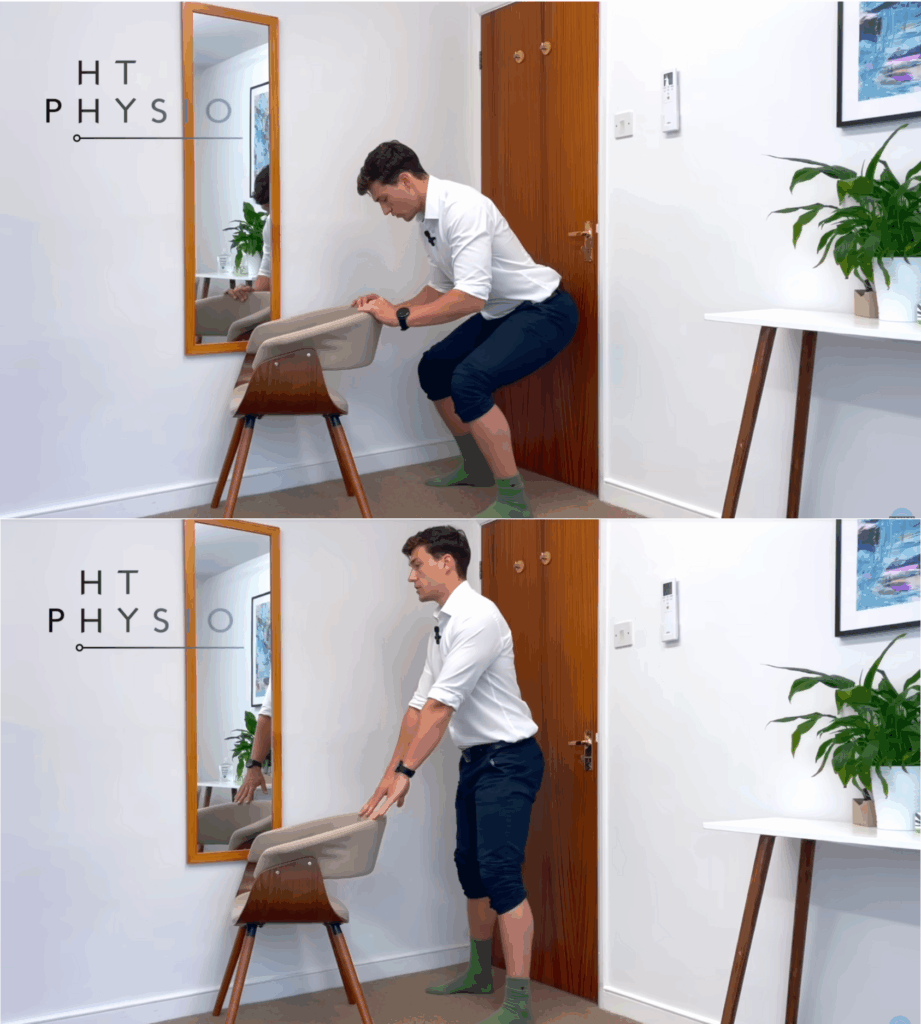If you struggle with swollen, heavy legs or find walking far is tough due to pain, arthritis, or fatigue, you can still boost circulation safely at home.
I’m Will Harlow, Over-50s Specialist Physiotherapist at HT Physio in Farnham, and below are four simple exercises I use with patients to help move fluid, reduce swelling, and make legs feel lighter.
DISCLAIMER: The information in this post is not a substitute for individualized medical advice and the exercises are not suitable for every person. Please get checked out before you start any new exercise programme.
Why Circulation Slows – and How to Help It
When you sit or stand still, blood can pool in the lower legs. Veins don’t have a strong “pump” of their own, so they rely on the muscle pump: every time your leg muscles contract, they gently squeeze the veins and push blood back up towards the heart.

If walking is hard right now, we can simulate that pump with targeted moves from a chair or the kitchen counter.
Goal: little and often. 1–3 minutes per exercise, 2–4 times per day if you’re not walking much.
Exercise 1: Ankle Pumps with Leg Elevation (Chair)
Best for: easing ankle/foot swelling; gentle warm-up.
You’ll need: a sturdy chair and a footstool (or second chair) with a couple of pillows.
How to do it
- Sit comfortably and elevate one leg so the foot is slightly higher than your hip (pillow on a stool works well).
- Point your toes down and then pull them up towards you – a smooth, brisk rhythm.
- Keep breathing; relax the shoulders and jaw.

Time: 1–3 minutes per leg.
Why it works: elevation helps fluid drain; your calf and shin muscles act as a pump to assist venous return.
Caution: Avoid this set-up if you have active sciatica in the elevated leg (it can aggravate symptoms). If unsure, skip elevation and do the next exercise.
Exercise 2: Seated Calf Raise (Soleus Focus)
Best for: building the “endurance pump” in the deep calf (soleus).
You’ll need: a sturdy chair.
How to do it
- Sit near the edge of the chair, feet flat, knees and hips about 90°.
- Lift both heels off the floor; pause 1 second at the top; lower with control.
- To progress, lean your forearms gently onto your thighs to add a bit of bodyweight, then repeat.

Reps/Sets: 15–20 reps, 2–3 sets.
Tempo: “Up 1, down 1” – fairly brisk to stimulate circulation.
Why it works: the soleus is a powerful venous pump active during standing and walking. Training it in sitting is a great option when steps are limited.
Exercise 3: Standing Calf Raise (Counter or Chair Support)
Best for: stronger push from the upper calf; great “through-the-day” booster.
You’ll need: a counter/back of a chair for balance.
How to do it
- Stand tall, feet hip-width, fingertips on support.
- Rise onto your tiptoes, then lower. Keep knees soft and posture tall.
- Aim for a snappy rhythm: up with two counts, down with two counts.

Reps/Sets: 10–20 reps, 2–3 sets.
Make it harder: try single-leg raises if safe and pain-free.
Everyday tip: pair a set with daily habits – kettle boils, adverts on TV, or after each loo break. Little “snacks” add up.
Exercise 4: Sit-to-Stand Squats (Shallow or Comfortable Depth)
Best for: whole-leg pump (quads + glutes), circulation and strength.
You’ll need: a chair; optional counter for support.
How to do it
- Stand in front of the chair, feet shoulder-width.
- Sit your hips back first, then bend the knees and touch (or nearly touch) the chair.
- Stand up tall again. Keep the chest open; knees track over toes (not collapsing in).
Reps/Sets: 10–15 reps, 1–3 sets.
Depth: only as far as comfortable. Even small squats (5–10 cm) wake up the pump and count.

Why it works: recruits large thigh and hip muscles – excellent for propelling blood once it has moved past the ankle and calf.
How to Put It Together (A Simple Day Plan)
- Morning: Ankle Pumps (1–3 min/leg) → Seated Calf Raise (2 × 15–20)
- Midday: Standing Calf Raise (2 × 15)
- Afternoon: Sit-to-Stand (1–3 × 10–15)
- Evening (optional): Repeat Ankle Pumps if swelling builds later in the day
If you’re already walking, you can reduce the frequency. If you currently have limited mobility, it is recommended to take small amounts multiple times.
If you’d like to see exactly how to do these exercises and follow along in real time, watch the video below – I walk you through each movement, explain how they work, and share simple ways to put them into practice safely at home.
Need Personalised Guidance?
If your legs feel heavy, tight, or swollen and you’re not sure where to start, book an assessment at HT Physio (Farnham). We’ll tailor a simple plan to your mobility level and medical history.
Author:
Will Harlow, MSc, MCSP – Over-50s Specialist Physiotherapist, HT Physio (Farnham, UK)
For more practical, over-50s strategies, you can also find my book Thriving Beyond 50 on Amazon.
